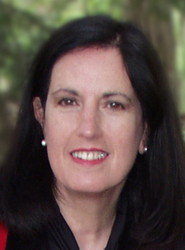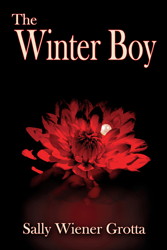
Welcome to December, and let me tell you, I for one am grateful to have November behind me. Typically, I tend to hit around six conventions a year; last month I did three. This in addition to a cross-country trip for the Thanksgiving holiday. I need a rest, and in fact I’m spending the day taking it easy and just hanging out with a good book; tomorrow I’ll fly back to Philadelphia and resume my regular routine.
In the meantime, let me introduce you to this week’s EATING AUTHORS guest, Sally Wiener Grotta. Her regular routine encompases an assortment of professions including author, journalist, photographer, digital artist, and public speaker, but as you begin to explore her work you quickly discover the common theme that ties it all together: Sally is a storyteller.
I’ll tell you about her fiction in a moment, but I’d be doing you and her a great disservice if I didn’t first direct you to her ongoing photography project, American Hands, in which her camera captures artisans from across the US in their respective workshops, from bookbinders and blacksmiths, to glassblowers and weavers. Take a moment to follow the link and check it out!
Back? Okay, moving on. Sally’s first book, Jo Joe, was a literary novel set in a Pennsylvania mountain village. Her second novel, The Winter Boy, debuted a few weeks ago and while no less literary takes off in a more speculative direction. There’s a poignancy to Sally’s work that will speak to you; all you have to do is listen.

LMS: Welcome, Sally. As I understand it, you don’t just have a memorable meal to share, you’ve actually brought us an adventure story! What happened?
SWG: The phone call came, as I remember, on a Monday.
“How about a weekend in the Amazon Jungle?â€
Daniel and I were used to receiving all kinds of exotic assignments; we’d been writing features and travel stories for glossy magazines for a number of years. But this was a first for us. Well, it was a first for a lot of people. A clan of Amazon Indians that no one had ever known to exist had recently come out of the jungle and were now living near “civilization.â€
“If you want to do the story, you’ll have to leave this Thursday, for a trek into the jungle on Friday. The return flight would be Monday.â€
If?! Of course, we wanted the assignment.
“Are your vaccinations up to date for the Amazon?â€
We’d recently returned from Asia, so we knew we had the normal inoculations. However, we didn’t realize until we started calling around that we would need a series of additional shots which were usually given over several weeks. Both our arms felt like pin cushions, but we made it to the airport in time for the long, long flight to Iquitos, Peru, by way of Miami, Florida.
Friday morning, the light on the Momon River (an Amazon tributary) was magical, a soft grey haze over the muddy brown water. We piled into a long, thin boat with a sputtering outboard motor with about five other journalists and our local guide. At first the water churned with the typical to and fro of a small harbor. Soon the haze burned off, and when we veered onto a much smaller river with far less boat traffic, the ride became a gentle roll.
Eventually, we made it to a small cobbled together wooden “pier,†where we began our trek through the jungle. Everything felt thick and heavy. Walls of trees, vines and bushes towered over the one-person wide trail. When it widened enough, I sprinted in front of the group, to photograph some of brightest, multi-hued flowers I’ve ever seen, and to capture portraits of my fellow trekkers in situ. Our guide laughed at my burst of energy in the growing humidity. Our shirts were soon clinging to our spines under our backpacks. The sweat didn’t start dripping into our eyes until later.
When we arrived at the tiny village in a small natural clearing, we were greeted by the clan: about twenty small sinewy natives, laughing and chatting away in their musical high-pitched voices. Most were under 20 years old with a few possibly as old as 45, though their typical life expectancy was about 30-35. All were wearing bark pictographic skirts. Seeds, nuts and even a few feathers adorned black shiny hair and were woven into necklaces. Many of the women were bare-breasted. I was significantly taller than their largest men, though I’m only 5’8â€, and I felt downright plump compared to their spare figures.
We sat on logs, while some danced and played reed pipes and others served us sweet fruit nectar, berries, melon and other local treats.
One of the universal laws of tribal life all over the globe is that hospitality is sacred. Under no circumstances is it appropriate to turn down offered delicacies.
A young girl approached me. From her tiny nub breasts, I guessed that she was about 11 or 12 years old. She held a small hollowed-out fruit shell to me. In it were what looked like raw cashews. Only… they squiggled. I had long ago read that live maggots are an important protein source for some cultures, but this was the first time I had actually seen any, let alone been offered some to eat.
I hesitated briefly, but her smile was so friendly and sincere. And I had no desire to insult her. So I dipped my fingers into the squirming mass, picked up a few and threw them into my mouth. They were quite crunchy, with an earthy taste not unlike the humus smell of the jungle itself.
The girl laughed happily, scooped some of the maggots into her mouth, then sat next to me, and we enjoyed her brother’s blowgun demonstration together. She was curious about the black boxes I pointed at everyone. Then I brought out my Polaroid camera (this was before digital photography), and she was amazed by the instant prints I gave out.
That trip was a few decades ago. I understand the clan has become quite sophisticated about interacting with (and earning money from) tourists. I’ve even read stories about lunches that are especially packaged by tour companies with various tribes. But the innocence of our early encounter was an eye-opener that I can’t imagine those slick tours capturing.
I think of that girl often, wondering how her life was changed by coming out of the jungle, seeing what to her must have been an exotic civilization. If she is still alive, does she tell her grandchildren about the big strange woman who made a magic picture of her? Does she show them that Polaroid print? Or did photography become so commonplace for her that any memory of me blurred with the many who followed in our tracks? Her grandchildren (great-grandchildren?) might even have cameras of their own. Do they even still relish the taste and nutritional value of maggots, or have they been seduced (and fattened up) by fast food?
I know that I was changed by her and her small family in ways that I am still trying to understand. One thing I can say for certain is that I have never been able to eat cashews again without remembering her… and without first looking to be sure they aren’t squiggling.

Thanks, Sally. Two things: First, you win a prize for using the phrase “nutritional value of maggots” on this blog. Second, I may never look at cashews the same again.
Next Monday: Another author and another meal!
#SFWApro
Tags: Eating Authors



Thanks, Lawrence. It was fun being on your blog and sharing my memories with you.
12.01.14 at 11:34 am